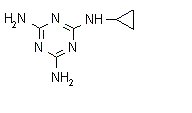Pesticides >> Insecticide >> Cyromazine
Cyromazine
Cyromazine 99%TC
Cyromazine 75%WDG
Cyromazine 75%WP
Cyromazine 50%WP
Insecticide

NOMENCLATURE
Common name cyromazine (BSI, draft E-ISO, (f) draft F-ISO, ANSI)
IUPAC name N-cyclopropyl-1,3,5-triazine-2,4,6-triamine
Chemical Abstracts name N-cyclopropyl-1,3,5-triazine-2,4,6-triamine
CAS RN [66215-27-8] Development codes CGA 72 662 (Ciba-Geigy) Official
codes OMS 2014
APPLICATIONS
Mode of action Insect growth regulator with contact action, which
interferes with moulting and pupation. When used on plants, action
is systemic: applied to the leaves, it exhibits a strong translaminar
effect; applied to the soil, it is taken up by the roots and translocated
acropetally. Uses Control of Diptera larvae in chicken manure by
feeding to the poultry or treating the breeding sites. Also used
to control flies on animals. Used as a foliar spray to control leaf
miners (Liriomyza spp.) in vegetables (e.g. celery, melons, tomatoes,
lettuce), mushrooms, potatoes and ornamentals, at 75-225 g/ha; also
used at 190-450 g/ha in drench or drip irrigation. Formulation types
SL; WP. Selected tradenames: 'Neporex' (for veterinary use) (Syngenta);
'Trigard' (for plant protection) (Syngenta); 'Vetrazin' (for veterinary
use) (Syngenta); 'Gilzine' (Gilmore)
OTHER TRADENAMES
'Armor' (Syngenta); 'Citation' (Syngenta); 'Larvadex' (Syngenta)
ANALYSIS
Product analysis by hplc. Residues determined by glc or hplc. Details
available from Syngenta.
MAMMALIAN TOXICOLOGY
Reviews FAO/WHO 59, 61 (see part 2 of the Bibliography). Oral Acute
oral LD50 for rats 3387 mg/kg. Skin and eye Acute percutaneous LD50
for rats >3100 mg/kg. Mild skin irritant; non-irritating to eyes
(rabbits). Inhalation LC50 (4 h) for rats >2.720 mg/l air. NOEL
(2 y) for rats 300, mice 1000 mg/kg diet. ADI (JMPR) 0.02 mg/kg
b.w. [1990]. Toxicity class WHO (a.i.) III (Table 5); EPA (formulation)
III
ECOTOXICOLOGY
Birds Acute oral LD50 for bobwhite quail 1785, Japanese quail 2338,
Pekin ducks >1000, mallard ducks >2510 mg/kg. Fish LC50 (96
h) for bluegill sunfish >90, carp, catfish and rainbow trout
>100 mg/l. Daphnia LC50 (48 h) >9.1 mg/l. Algae LC50 124 mg/l.
Bees Non-toxic to adult honeybees (no contact action up to 5 mg/bee).
Worms LC50 >1000 mg/kg. Other beneficial spp. Non-toxic.
ENVIRONMENTAL FATE
Animals In rats, cyromazine is efficiently excreted, mainly as the
parent compound. Plants Rapidly metabolised in plants. The principal
metabolite is melamine. Soil/Environment Cyromazine and its main
metabolite melamine are moderately mobile. Numerous studies conducted
(laboratory and field) demonstrate that cyromazine is efficiently
degraded by biological mechanisms.